Macroeconomics and Market Structures: A Study of UK's Monetary and Fiscal Policies
VerifiedAdded on 2023/06/05
|8
|2596
|74
AI Summary
This article discusses the impact of UK's monetary and fiscal policies on the economy, including the role of the monetary policy committee, fiscal policy, and economic cycles. It also explores the concepts of economic growth and market structures, specifically monopoly and perfect competition.
Contribute Materials
Your contribution can guide someone’s learning journey. Share your
documents today.
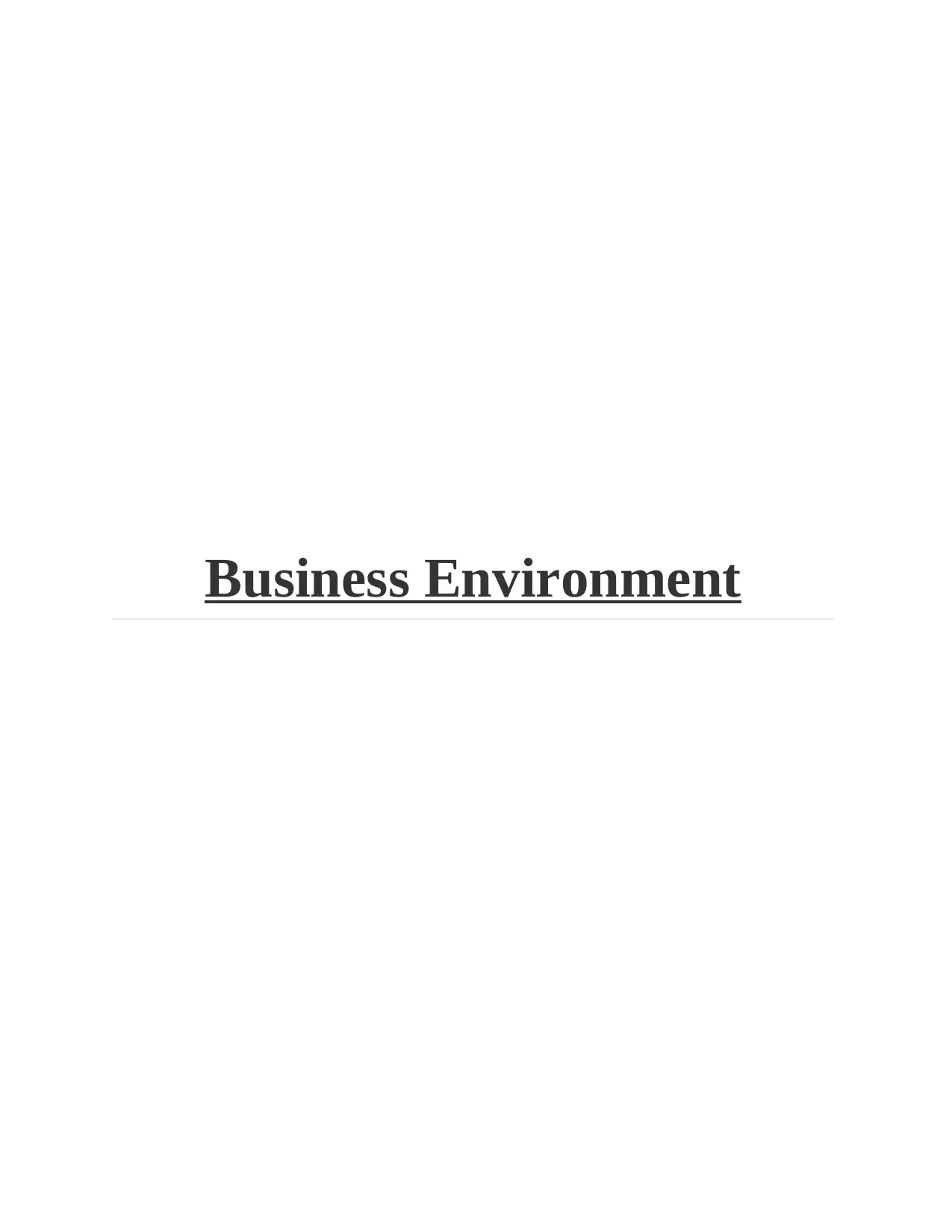
Business Environment
Secure Best Marks with AI Grader
Need help grading? Try our AI Grader for instant feedback on your assignments.
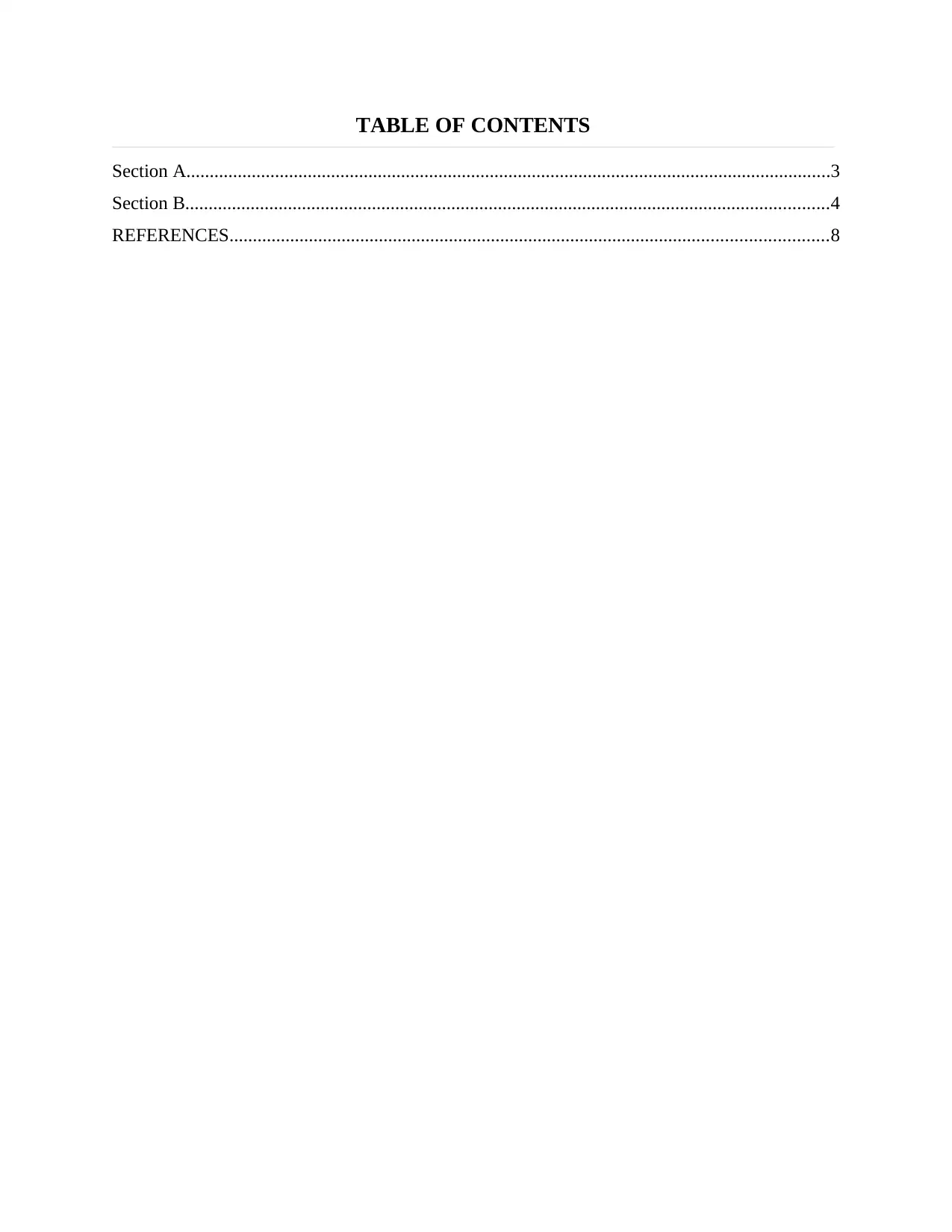
TABLE OF CONTENTS
Section A..........................................................................................................................................3
Section B..........................................................................................................................................4
REFERENCES................................................................................................................................8
Section A..........................................................................................................................................3
Section B..........................................................................................................................................4
REFERENCES................................................................................................................................8
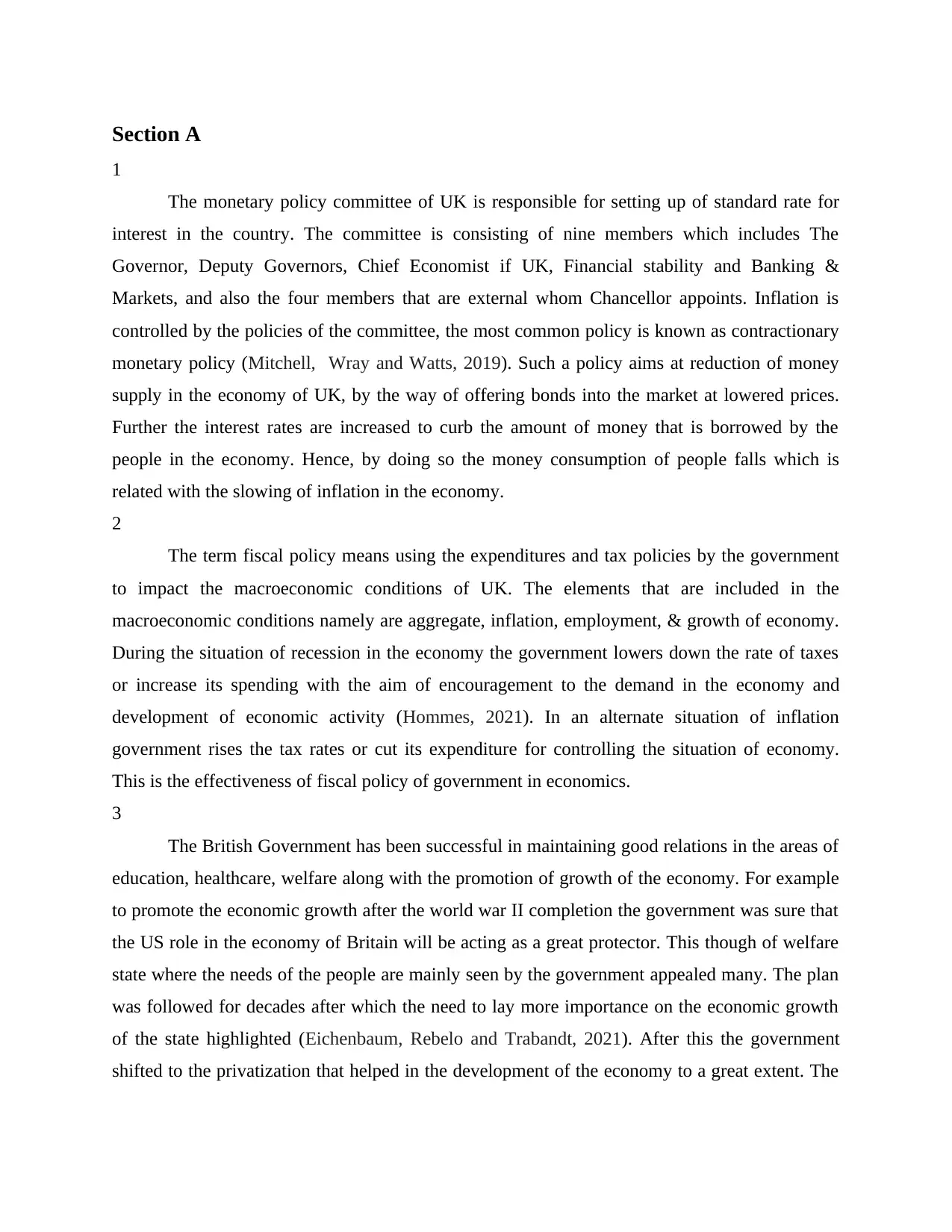
Section A
1
The monetary policy committee of UK is responsible for setting up of standard rate for
interest in the country. The committee is consisting of nine members which includes The
Governor, Deputy Governors, Chief Economist if UK, Financial stability and Banking &
Markets, and also the four members that are external whom Chancellor appoints. Inflation is
controlled by the policies of the committee, the most common policy is known as contractionary
monetary policy (Mitchell, Wray and Watts, 2019). Such a policy aims at reduction of money
supply in the economy of UK, by the way of offering bonds into the market at lowered prices.
Further the interest rates are increased to curb the amount of money that is borrowed by the
people in the economy. Hence, by doing so the money consumption of people falls which is
related with the slowing of inflation in the economy.
2
The term fiscal policy means using the expenditures and tax policies by the government
to impact the macroeconomic conditions of UK. The elements that are included in the
macroeconomic conditions namely are aggregate, inflation, employment, & growth of economy.
During the situation of recession in the economy the government lowers down the rate of taxes
or increase its spending with the aim of encouragement to the demand in the economy and
development of economic activity (Hommes, 2021). In an alternate situation of inflation
government rises the tax rates or cut its expenditure for controlling the situation of economy.
This is the effectiveness of fiscal policy of government in economics.
3
The British Government has been successful in maintaining good relations in the areas of
education, healthcare, welfare along with the promotion of growth of the economy. For example
to promote the economic growth after the world war II completion the government was sure that
the US role in the economy of Britain will be acting as a great protector. This though of welfare
state where the needs of the people are mainly seen by the government appealed many. The plan
was followed for decades after which the need to lay more importance on the economic growth
of the state highlighted (Eichenbaum, Rebelo and Trabandt, 2021). After this the government
shifted to the privatization that helped in the development of the economy to a great extent. The
1
The monetary policy committee of UK is responsible for setting up of standard rate for
interest in the country. The committee is consisting of nine members which includes The
Governor, Deputy Governors, Chief Economist if UK, Financial stability and Banking &
Markets, and also the four members that are external whom Chancellor appoints. Inflation is
controlled by the policies of the committee, the most common policy is known as contractionary
monetary policy (Mitchell, Wray and Watts, 2019). Such a policy aims at reduction of money
supply in the economy of UK, by the way of offering bonds into the market at lowered prices.
Further the interest rates are increased to curb the amount of money that is borrowed by the
people in the economy. Hence, by doing so the money consumption of people falls which is
related with the slowing of inflation in the economy.
2
The term fiscal policy means using the expenditures and tax policies by the government
to impact the macroeconomic conditions of UK. The elements that are included in the
macroeconomic conditions namely are aggregate, inflation, employment, & growth of economy.
During the situation of recession in the economy the government lowers down the rate of taxes
or increase its spending with the aim of encouragement to the demand in the economy and
development of economic activity (Hommes, 2021). In an alternate situation of inflation
government rises the tax rates or cut its expenditure for controlling the situation of economy.
This is the effectiveness of fiscal policy of government in economics.
3
The British Government has been successful in maintaining good relations in the areas of
education, healthcare, welfare along with the promotion of growth of the economy. For example
to promote the economic growth after the world war II completion the government was sure that
the US role in the economy of Britain will be acting as a great protector. This though of welfare
state where the needs of the people are mainly seen by the government appealed many. The plan
was followed for decades after which the need to lay more importance on the economic growth
of the state highlighted (Eichenbaum, Rebelo and Trabandt, 2021). After this the government
shifted to the privatization that helped in the development of the economy to a great extent. The
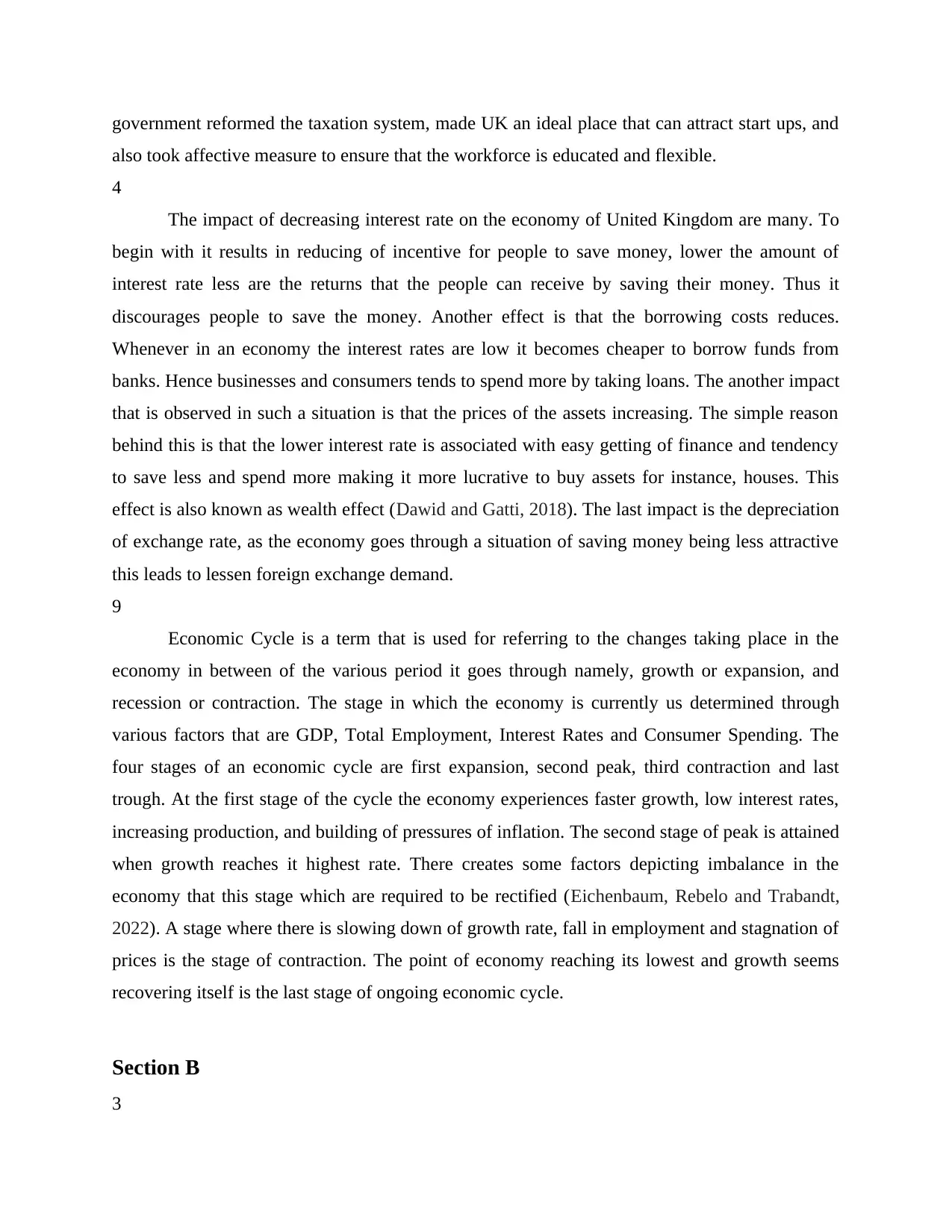
government reformed the taxation system, made UK an ideal place that can attract start ups, and
also took affective measure to ensure that the workforce is educated and flexible.
4
The impact of decreasing interest rate on the economy of United Kingdom are many. To
begin with it results in reducing of incentive for people to save money, lower the amount of
interest rate less are the returns that the people can receive by saving their money. Thus it
discourages people to save the money. Another effect is that the borrowing costs reduces.
Whenever in an economy the interest rates are low it becomes cheaper to borrow funds from
banks. Hence businesses and consumers tends to spend more by taking loans. The another impact
that is observed in such a situation is that the prices of the assets increasing. The simple reason
behind this is that the lower interest rate is associated with easy getting of finance and tendency
to save less and spend more making it more lucrative to buy assets for instance, houses. This
effect is also known as wealth effect (Dawid and Gatti, 2018). The last impact is the depreciation
of exchange rate, as the economy goes through a situation of saving money being less attractive
this leads to lessen foreign exchange demand.
9
Economic Cycle is a term that is used for referring to the changes taking place in the
economy in between of the various period it goes through namely, growth or expansion, and
recession or contraction. The stage in which the economy is currently us determined through
various factors that are GDP, Total Employment, Interest Rates and Consumer Spending. The
four stages of an economic cycle are first expansion, second peak, third contraction and last
trough. At the first stage of the cycle the economy experiences faster growth, low interest rates,
increasing production, and building of pressures of inflation. The second stage of peak is attained
when growth reaches it highest rate. There creates some factors depicting imbalance in the
economy that this stage which are required to be rectified (Eichenbaum, Rebelo and Trabandt,
2022). A stage where there is slowing down of growth rate, fall in employment and stagnation of
prices is the stage of contraction. The point of economy reaching its lowest and growth seems
recovering itself is the last stage of ongoing economic cycle.
Section B
3
also took affective measure to ensure that the workforce is educated and flexible.
4
The impact of decreasing interest rate on the economy of United Kingdom are many. To
begin with it results in reducing of incentive for people to save money, lower the amount of
interest rate less are the returns that the people can receive by saving their money. Thus it
discourages people to save the money. Another effect is that the borrowing costs reduces.
Whenever in an economy the interest rates are low it becomes cheaper to borrow funds from
banks. Hence businesses and consumers tends to spend more by taking loans. The another impact
that is observed in such a situation is that the prices of the assets increasing. The simple reason
behind this is that the lower interest rate is associated with easy getting of finance and tendency
to save less and spend more making it more lucrative to buy assets for instance, houses. This
effect is also known as wealth effect (Dawid and Gatti, 2018). The last impact is the depreciation
of exchange rate, as the economy goes through a situation of saving money being less attractive
this leads to lessen foreign exchange demand.
9
Economic Cycle is a term that is used for referring to the changes taking place in the
economy in between of the various period it goes through namely, growth or expansion, and
recession or contraction. The stage in which the economy is currently us determined through
various factors that are GDP, Total Employment, Interest Rates and Consumer Spending. The
four stages of an economic cycle are first expansion, second peak, third contraction and last
trough. At the first stage of the cycle the economy experiences faster growth, low interest rates,
increasing production, and building of pressures of inflation. The second stage of peak is attained
when growth reaches it highest rate. There creates some factors depicting imbalance in the
economy that this stage which are required to be rectified (Eichenbaum, Rebelo and Trabandt,
2022). A stage where there is slowing down of growth rate, fall in employment and stagnation of
prices is the stage of contraction. The point of economy reaching its lowest and growth seems
recovering itself is the last stage of ongoing economic cycle.
Section B
3
Secure Best Marks with AI Grader
Need help grading? Try our AI Grader for instant feedback on your assignments.
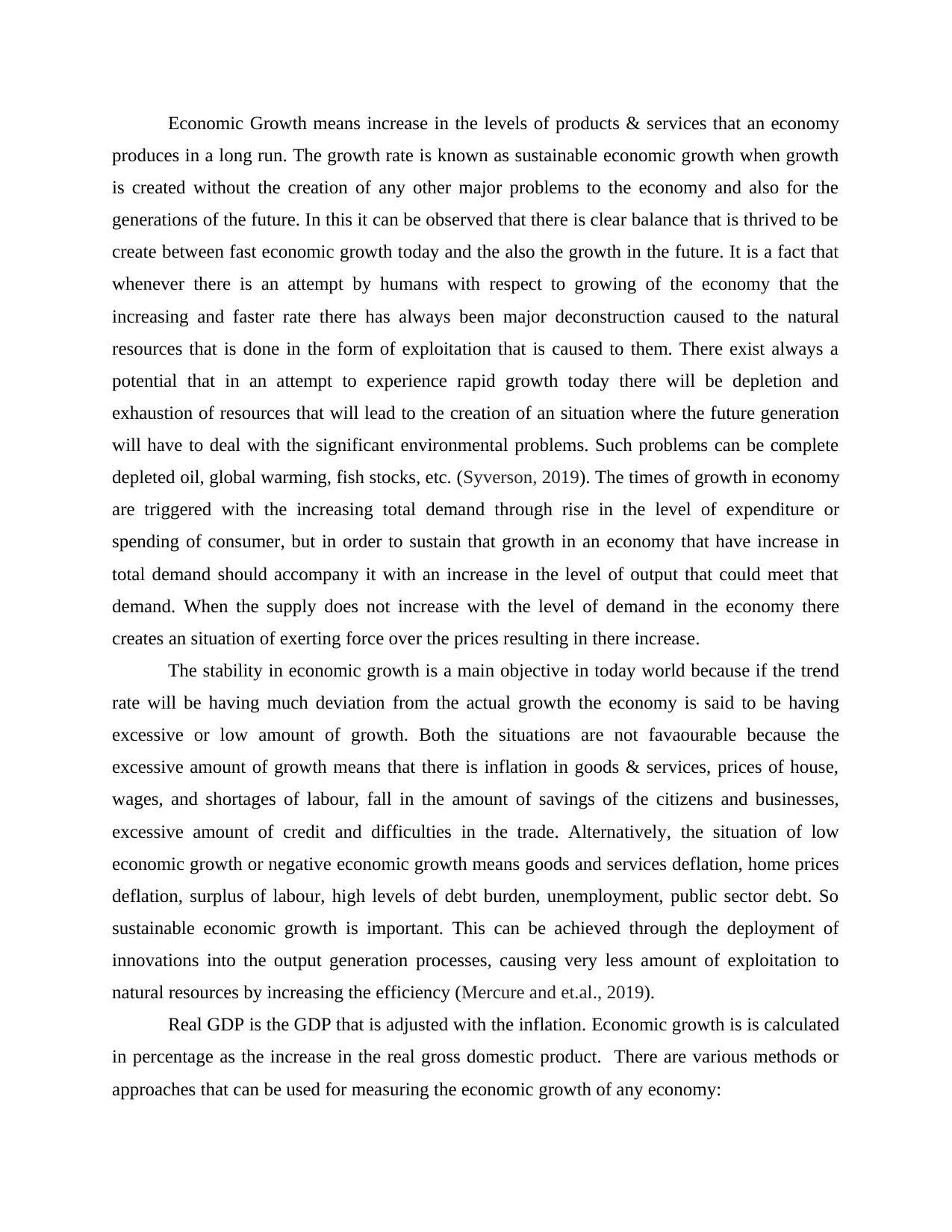
Economic Growth means increase in the levels of products & services that an economy
produces in a long run. The growth rate is known as sustainable economic growth when growth
is created without the creation of any other major problems to the economy and also for the
generations of the future. In this it can be observed that there is clear balance that is thrived to be
create between fast economic growth today and the also the growth in the future. It is a fact that
whenever there is an attempt by humans with respect to growing of the economy that the
increasing and faster rate there has always been major deconstruction caused to the natural
resources that is done in the form of exploitation that is caused to them. There exist always a
potential that in an attempt to experience rapid growth today there will be depletion and
exhaustion of resources that will lead to the creation of an situation where the future generation
will have to deal with the significant environmental problems. Such problems can be complete
depleted oil, global warming, fish stocks, etc. (Syverson, 2019). The times of growth in economy
are triggered with the increasing total demand through rise in the level of expenditure or
spending of consumer, but in order to sustain that growth in an economy that have increase in
total demand should accompany it with an increase in the level of output that could meet that
demand. When the supply does not increase with the level of demand in the economy there
creates an situation of exerting force over the prices resulting in there increase.
The stability in economic growth is a main objective in today world because if the trend
rate will be having much deviation from the actual growth the economy is said to be having
excessive or low amount of growth. Both the situations are not favaourable because the
excessive amount of growth means that there is inflation in goods & services, prices of house,
wages, and shortages of labour, fall in the amount of savings of the citizens and businesses,
excessive amount of credit and difficulties in the trade. Alternatively, the situation of low
economic growth or negative economic growth means goods and services deflation, home prices
deflation, surplus of labour, high levels of debt burden, unemployment, public sector debt. So
sustainable economic growth is important. This can be achieved through the deployment of
innovations into the output generation processes, causing very less amount of exploitation to
natural resources by increasing the efficiency (Mercure and et.al., 2019).
Real GDP is the GDP that is adjusted with the inflation. Economic growth is is calculated
in percentage as the increase in the real gross domestic product. There are various methods or
approaches that can be used for measuring the economic growth of any economy:
produces in a long run. The growth rate is known as sustainable economic growth when growth
is created without the creation of any other major problems to the economy and also for the
generations of the future. In this it can be observed that there is clear balance that is thrived to be
create between fast economic growth today and the also the growth in the future. It is a fact that
whenever there is an attempt by humans with respect to growing of the economy that the
increasing and faster rate there has always been major deconstruction caused to the natural
resources that is done in the form of exploitation that is caused to them. There exist always a
potential that in an attempt to experience rapid growth today there will be depletion and
exhaustion of resources that will lead to the creation of an situation where the future generation
will have to deal with the significant environmental problems. Such problems can be complete
depleted oil, global warming, fish stocks, etc. (Syverson, 2019). The times of growth in economy
are triggered with the increasing total demand through rise in the level of expenditure or
spending of consumer, but in order to sustain that growth in an economy that have increase in
total demand should accompany it with an increase in the level of output that could meet that
demand. When the supply does not increase with the level of demand in the economy there
creates an situation of exerting force over the prices resulting in there increase.
The stability in economic growth is a main objective in today world because if the trend
rate will be having much deviation from the actual growth the economy is said to be having
excessive or low amount of growth. Both the situations are not favaourable because the
excessive amount of growth means that there is inflation in goods & services, prices of house,
wages, and shortages of labour, fall in the amount of savings of the citizens and businesses,
excessive amount of credit and difficulties in the trade. Alternatively, the situation of low
economic growth or negative economic growth means goods and services deflation, home prices
deflation, surplus of labour, high levels of debt burden, unemployment, public sector debt. So
sustainable economic growth is important. This can be achieved through the deployment of
innovations into the output generation processes, causing very less amount of exploitation to
natural resources by increasing the efficiency (Mercure and et.al., 2019).
Real GDP is the GDP that is adjusted with the inflation. Economic growth is is calculated
in percentage as the increase in the real gross domestic product. There are various methods or
approaches that can be used for measuring the economic growth of any economy:
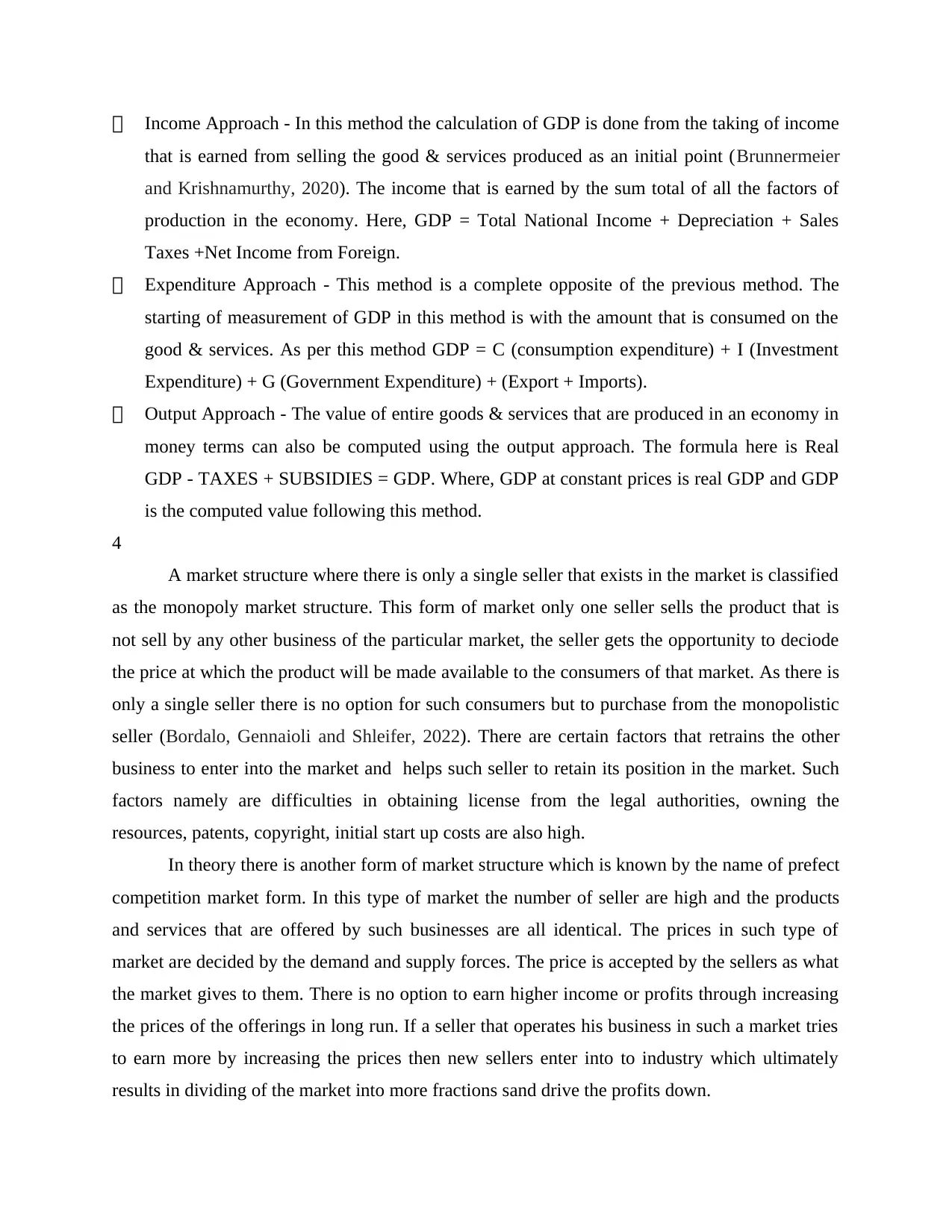
Income Approach - In this method the calculation of GDP is done from the taking of income
that is earned from selling the good & services produced as an initial point (Brunnermeier
and Krishnamurthy, 2020). The income that is earned by the sum total of all the factors of
production in the economy. Here, GDP = Total National Income + Depreciation + Sales
Taxes +Net Income from Foreign.
Expenditure Approach - This method is a complete opposite of the previous method. The
starting of measurement of GDP in this method is with the amount that is consumed on the
good & services. As per this method GDP = C (consumption expenditure) + I (Investment
Expenditure) + G (Government Expenditure) + (Export + Imports).
Output Approach - The value of entire goods & services that are produced in an economy in
money terms can also be computed using the output approach. The formula here is Real
GDP - TAXES + SUBSIDIES = GDP. Where, GDP at constant prices is real GDP and GDP
is the computed value following this method.
4
A market structure where there is only a single seller that exists in the market is classified
as the monopoly market structure. This form of market only one seller sells the product that is
not sell by any other business of the particular market, the seller gets the opportunity to deciode
the price at which the product will be made available to the consumers of that market. As there is
only a single seller there is no option for such consumers but to purchase from the monopolistic
seller (Bordalo, Gennaioli and Shleifer, 2022). There are certain factors that retrains the other
business to enter into the market and helps such seller to retain its position in the market. Such
factors namely are difficulties in obtaining license from the legal authorities, owning the
resources, patents, copyright, initial start up costs are also high.
In theory there is another form of market structure which is known by the name of prefect
competition market form. In this type of market the number of seller are high and the products
and services that are offered by such businesses are all identical. The prices in such type of
market are decided by the demand and supply forces. The price is accepted by the sellers as what
the market gives to them. There is no option to earn higher income or profits through increasing
the prices of the offerings in long run. If a seller that operates his business in such a market tries
to earn more by increasing the prices then new sellers enter into to industry which ultimately
results in dividing of the market into more fractions sand drive the profits down.
that is earned from selling the good & services produced as an initial point (Brunnermeier
and Krishnamurthy, 2020). The income that is earned by the sum total of all the factors of
production in the economy. Here, GDP = Total National Income + Depreciation + Sales
Taxes +Net Income from Foreign.
Expenditure Approach - This method is a complete opposite of the previous method. The
starting of measurement of GDP in this method is with the amount that is consumed on the
good & services. As per this method GDP = C (consumption expenditure) + I (Investment
Expenditure) + G (Government Expenditure) + (Export + Imports).
Output Approach - The value of entire goods & services that are produced in an economy in
money terms can also be computed using the output approach. The formula here is Real
GDP - TAXES + SUBSIDIES = GDP. Where, GDP at constant prices is real GDP and GDP
is the computed value following this method.
4
A market structure where there is only a single seller that exists in the market is classified
as the monopoly market structure. This form of market only one seller sells the product that is
not sell by any other business of the particular market, the seller gets the opportunity to deciode
the price at which the product will be made available to the consumers of that market. As there is
only a single seller there is no option for such consumers but to purchase from the monopolistic
seller (Bordalo, Gennaioli and Shleifer, 2022). There are certain factors that retrains the other
business to enter into the market and helps such seller to retain its position in the market. Such
factors namely are difficulties in obtaining license from the legal authorities, owning the
resources, patents, copyright, initial start up costs are also high.
In theory there is another form of market structure which is known by the name of prefect
competition market form. In this type of market the number of seller are high and the products
and services that are offered by such businesses are all identical. The prices in such type of
market are decided by the demand and supply forces. The price is accepted by the sellers as what
the market gives to them. There is no option to earn higher income or profits through increasing
the prices of the offerings in long run. If a seller that operates his business in such a market tries
to earn more by increasing the prices then new sellers enter into to industry which ultimately
results in dividing of the market into more fractions sand drive the profits down.
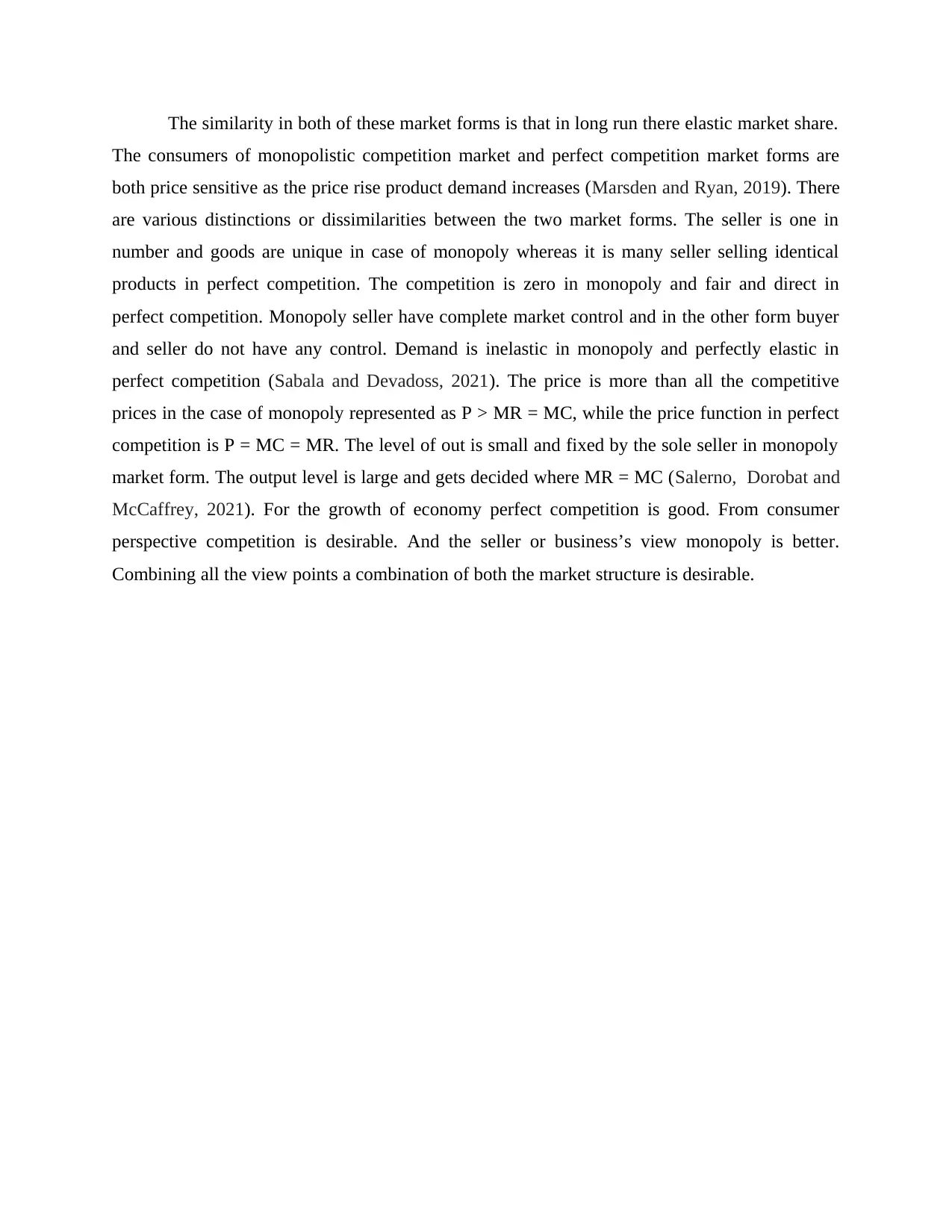
The similarity in both of these market forms is that in long run there elastic market share.
The consumers of monopolistic competition market and perfect competition market forms are
both price sensitive as the price rise product demand increases (Marsden and Ryan, 2019). There
are various distinctions or dissimilarities between the two market forms. The seller is one in
number and goods are unique in case of monopoly whereas it is many seller selling identical
products in perfect competition. The competition is zero in monopoly and fair and direct in
perfect competition. Monopoly seller have complete market control and in the other form buyer
and seller do not have any control. Demand is inelastic in monopoly and perfectly elastic in
perfect competition (Sabala and Devadoss, 2021). The price is more than all the competitive
prices in the case of monopoly represented as P > MR = MC, while the price function in perfect
competition is P = MC = MR. The level of out is small and fixed by the sole seller in monopoly
market form. The output level is large and gets decided where MR = MC (Salerno, Dorobat and
McCaffrey, 2021). For the growth of economy perfect competition is good. From consumer
perspective competition is desirable. And the seller or business’s view monopoly is better.
Combining all the view points a combination of both the market structure is desirable.
The consumers of monopolistic competition market and perfect competition market forms are
both price sensitive as the price rise product demand increases (Marsden and Ryan, 2019). There
are various distinctions or dissimilarities between the two market forms. The seller is one in
number and goods are unique in case of monopoly whereas it is many seller selling identical
products in perfect competition. The competition is zero in monopoly and fair and direct in
perfect competition. Monopoly seller have complete market control and in the other form buyer
and seller do not have any control. Demand is inelastic in monopoly and perfectly elastic in
perfect competition (Sabala and Devadoss, 2021). The price is more than all the competitive
prices in the case of monopoly represented as P > MR = MC, while the price function in perfect
competition is P = MC = MR. The level of out is small and fixed by the sole seller in monopoly
market form. The output level is large and gets decided where MR = MC (Salerno, Dorobat and
McCaffrey, 2021). For the growth of economy perfect competition is good. From consumer
perspective competition is desirable. And the seller or business’s view monopoly is better.
Combining all the view points a combination of both the market structure is desirable.
Paraphrase This Document
Need a fresh take? Get an instant paraphrase of this document with our AI Paraphraser
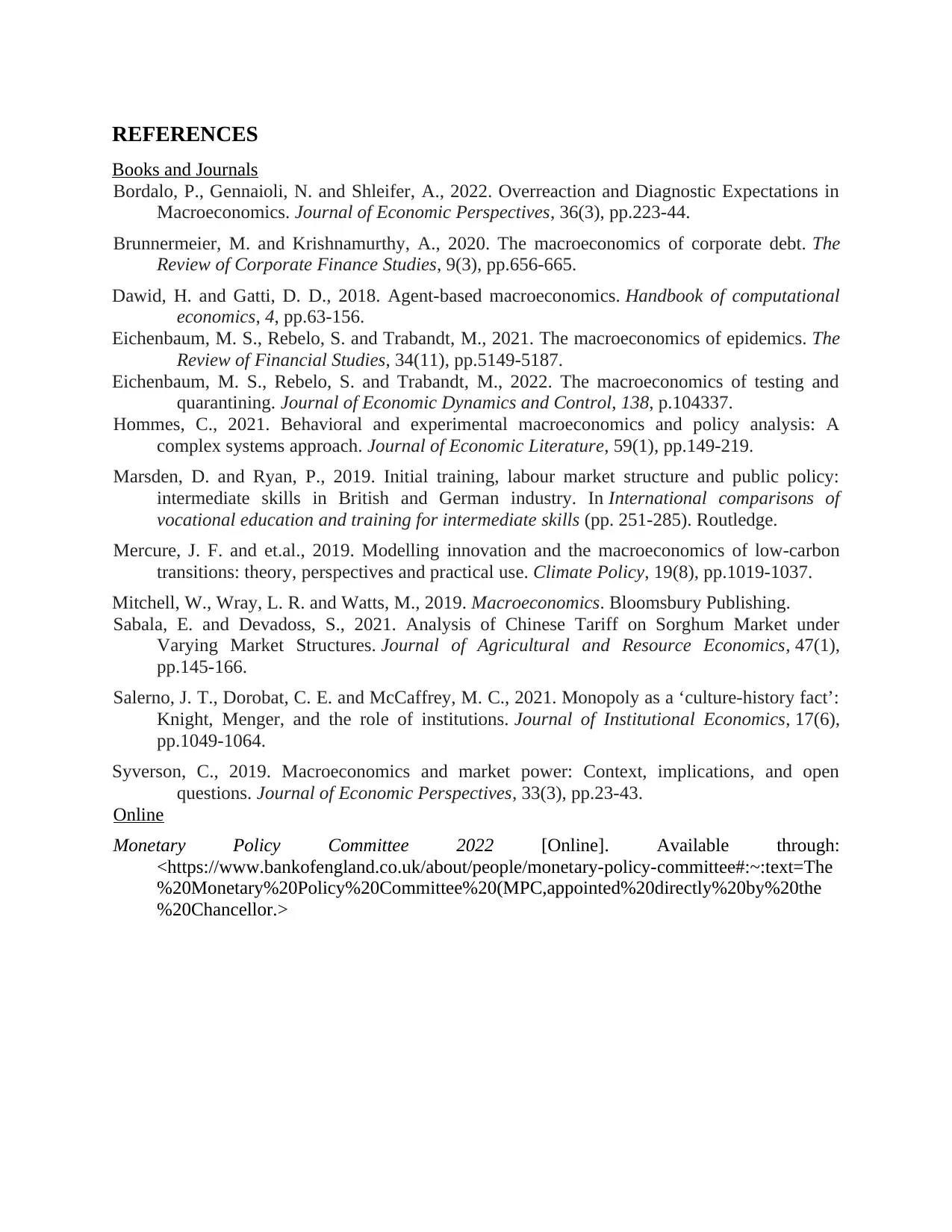
REFERENCES
Books and Journals
Bordalo, P., Gennaioli, N. and Shleifer, A., 2022. Overreaction and Diagnostic Expectations in
Macroeconomics. Journal of Economic Perspectives, 36(3), pp.223-44.
Brunnermeier, M. and Krishnamurthy, A., 2020. The macroeconomics of corporate debt. The
Review of Corporate Finance Studies, 9(3), pp.656-665.
Dawid, H. and Gatti, D. D., 2018. Agent-based macroeconomics. Handbook of computational
economics, 4, pp.63-156.
Eichenbaum, M. S., Rebelo, S. and Trabandt, M., 2021. The macroeconomics of epidemics. The
Review of Financial Studies, 34(11), pp.5149-5187.
Eichenbaum, M. S., Rebelo, S. and Trabandt, M., 2022. The macroeconomics of testing and
quarantining. Journal of Economic Dynamics and Control, 138, p.104337.
Hommes, C., 2021. Behavioral and experimental macroeconomics and policy analysis: A
complex systems approach. Journal of Economic Literature, 59(1), pp.149-219.
Marsden, D. and Ryan, P., 2019. Initial training, labour market structure and public policy:
intermediate skills in British and German industry. In International comparisons of
vocational education and training for intermediate skills (pp. 251-285). Routledge.
Mercure, J. F. and et.al., 2019. Modelling innovation and the macroeconomics of low-carbon
transitions: theory, perspectives and practical use. Climate Policy, 19(8), pp.1019-1037.
Mitchell, W., Wray, L. R. and Watts, M., 2019. Macroeconomics. Bloomsbury Publishing.
Sabala, E. and Devadoss, S., 2021. Analysis of Chinese Tariff on Sorghum Market under
Varying Market Structures. Journal of Agricultural and Resource Economics, 47(1),
pp.145-166.
Salerno, J. T., Dorobat, C. E. and McCaffrey, M. C., 2021. Monopoly as a ‘culture-history fact’:
Knight, Menger, and the role of institutions. Journal of Institutional Economics, 17(6),
pp.1049-1064.
Syverson, C., 2019. Macroeconomics and market power: Context, implications, and open
questions. Journal of Economic Perspectives, 33(3), pp.23-43.
Online
Monetary Policy Committee 2022 [Online]. Available through:
<https://www.bankofengland.co.uk/about/people/monetary-policy-committee#:~:text=The
%20Monetary%20Policy%20Committee%20(MPC,appointed%20directly%20by%20the
%20Chancellor.>
Books and Journals
Bordalo, P., Gennaioli, N. and Shleifer, A., 2022. Overreaction and Diagnostic Expectations in
Macroeconomics. Journal of Economic Perspectives, 36(3), pp.223-44.
Brunnermeier, M. and Krishnamurthy, A., 2020. The macroeconomics of corporate debt. The
Review of Corporate Finance Studies, 9(3), pp.656-665.
Dawid, H. and Gatti, D. D., 2018. Agent-based macroeconomics. Handbook of computational
economics, 4, pp.63-156.
Eichenbaum, M. S., Rebelo, S. and Trabandt, M., 2021. The macroeconomics of epidemics. The
Review of Financial Studies, 34(11), pp.5149-5187.
Eichenbaum, M. S., Rebelo, S. and Trabandt, M., 2022. The macroeconomics of testing and
quarantining. Journal of Economic Dynamics and Control, 138, p.104337.
Hommes, C., 2021. Behavioral and experimental macroeconomics and policy analysis: A
complex systems approach. Journal of Economic Literature, 59(1), pp.149-219.
Marsden, D. and Ryan, P., 2019. Initial training, labour market structure and public policy:
intermediate skills in British and German industry. In International comparisons of
vocational education and training for intermediate skills (pp. 251-285). Routledge.
Mercure, J. F. and et.al., 2019. Modelling innovation and the macroeconomics of low-carbon
transitions: theory, perspectives and practical use. Climate Policy, 19(8), pp.1019-1037.
Mitchell, W., Wray, L. R. and Watts, M., 2019. Macroeconomics. Bloomsbury Publishing.
Sabala, E. and Devadoss, S., 2021. Analysis of Chinese Tariff on Sorghum Market under
Varying Market Structures. Journal of Agricultural and Resource Economics, 47(1),
pp.145-166.
Salerno, J. T., Dorobat, C. E. and McCaffrey, M. C., 2021. Monopoly as a ‘culture-history fact’:
Knight, Menger, and the role of institutions. Journal of Institutional Economics, 17(6),
pp.1049-1064.
Syverson, C., 2019. Macroeconomics and market power: Context, implications, and open
questions. Journal of Economic Perspectives, 33(3), pp.23-43.
Online
Monetary Policy Committee 2022 [Online]. Available through:
<https://www.bankofengland.co.uk/about/people/monetary-policy-committee#:~:text=The
%20Monetary%20Policy%20Committee%20(MPC,appointed%20directly%20by%20the
%20Chancellor.>
1 out of 8
Related Documents
Your All-in-One AI-Powered Toolkit for Academic Success.
+13062052269
info@desklib.com
Available 24*7 on WhatsApp / Email
![[object Object]](/_next/static/media/star-bottom.7253800d.svg)
Unlock your academic potential
© 2024 | Zucol Services PVT LTD | All rights reserved.



